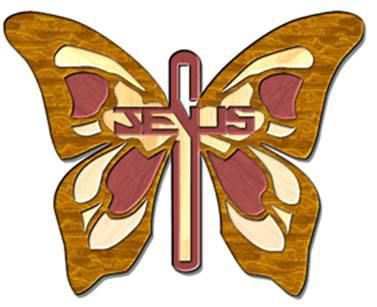I bet you’re wondering why I asked for that last reading! And maybe why I have quite so many butterfly brooches on a dress which also has butterflies on it!
Well, you see, for me, butterflies mean Easter.
Our
very hungry caterpillar ate and ate and grew and grew until it was
time for him to become a pupa, and after two weeks, he emerged as a
beautiful butterfly.
But, you see, pupating isn’t just a
matter of hibernating, like a dormouse or bear;
to become a
butterfly, caterpillars have to be completely remade.
While they
are in the pupa, all their bits dissolve away,
and are remade
from scratch, from the material that is there.
It’s not just a
matter of rearranging what is there,
it’s a matter of total
breakdown and starting again.
The caterpillar more-or-less has
to die before it can become a butterfly.
If you were to open up
a pupa a few days after the caterpillar had made it –
which
please don’t –
you would just find sort of goo.
That
is seriously scary.
Especially as something of the same sort of
thing happened to Jesus,
before he was raised from death,
and
may well happen to us, too.
We will be remade and raised in some
kind of spiritual body, so St Paul says.
I’ve brought us
some chocolate butterflies this morning, rather than eggs –
although eggs are also a symbol of resurrection.
We eat our
breakfast eggs and enjoy them,
but if an egg is fertilised and
incubated, it goes on to hatch out into a bird –
the bird
grows from scratch inside the egg,
but then has to peck its way
out, or it will perish.
Would you children like to give
the butterflies out?
One to everybody –
I’ve also got
jelly sweets in my bag if anybody would prefer one.
That’s
right.
You can keep any leftovers, but give them to your
grown-up to look after until after the service is over.
I
love the Bible readings they give us today. Particularly the story
from John’s gospel. John isn’t known for personal glimpses the
way the other gospels are, but this whole account sounds as though it
was taken from a very early source –
you know, of course, that
the gospels were not written down for several decades after the
Resurrection,
but obviously took their material from earlier
works, either written or oral.
Perhaps John himself, or even
Mary Magdalen, told this story!
It’s the details –
Mary,
coming early in the morning, probably around 5 am,
to finish
embalming the body, and finding it not there.
And she runs to
tell the others, and Peter and John come, and look inside,
and
they see that, although there is obviously no body in there,
the
actual grave clothes in which it had been wound are still there,
with the headpiece separate.
You couldn’t actually do
that without disturbing them, surely?
Peter and John head
off back to the others,
but Mary stays, still in tears,
because she needs to be by the body, or at least by the tomb,
to get her grieving done.
And when a man, whom she assumes
is the gardener, asks her what’s wrong, she says again, “Where is
he?
Have you moved him?
Where did you put him?
Please
tell me, please?”
And then the man suddenly says, in
that well-known, familiar, much-loved voice:
“Mary!”
And
Mary takes another look.
She blinks.
She rubs her eyes.
She
pinches herself.
No, she’s not dreaming.
It really,
really is!
“Oh, my dearest Lord!” she cries, and flings
herself into his arms.
We’re not told how long they
spent hugging, talking, explaining and weeping in each other’s
arms,
but eventually Jesus gently explains that,
although
he’s perfectly alive, and that this is a really real body one can
hug,
he won’t be around on earth forever,
but will
ascend to the Father.
He can’t stop with Mary for now, but she
should go back
and tell the others all about it.
And so,
we are told, she does.
So Peter and Mary both knew, from
their own knowledge,
that Jesus was raised from the dead in a
physical body they could hug,
and walk and talk with,
and
eat and drink with.
We know from some other accounts that there
were some differences
and not everybody recognised him at
first,
which isn’t too improbable when you think how
difficult it is, sometimes, to recognise people out of context –
if
you meet your hairdresser in the street, for instance.
And
if you thought Jesus was dead and buried,
how very difficult to
recognise him when he came and walked along with you,
as he did
with Cleopas and his wife that same evening.
So all
right.
But then, why does it matter?
It is something that
happened two thousand years ago, isn’t it?
Long ago in
history.
Well yes, it is.
But it is also central to
our faith.
St Paul says, in his letter to the Corinthians,
that
if Christ hasn’t been raised, then he –
Paul –
is a
fraud,
our sins are not forgiven,
and we might as well
eat our chocolate at home!
As it is, because Christ has
been raised, our sins are forgiven!
And we can have life,
abundant life.
And, it appears, that just as Christ was raised,
so shall we be raised from death –
our bodies will
obviously wear out or rust out one day no matter what we do,
and
while we may be given “notice to quit”, as it were,
it may
happen very suddenly.
But we believe that because Christ was
raised,
so we, too, shall be raised to eternal life with
him.
And we will be changed.
Christ has been raised,
and we will be raised.
And we believe, too, that because
Christ was raised,
we can be filled with his Holy Spirit,
just
as the disciples were on that long-ago day of Pentecost.
So we
don’t have to face going through the transformation that will occur
all by ourselves;
the Holy Spirit will be with us, strengthening
us and enabling us to cope.
Not just when we have died, but
here, now, today.
As we allow the risen Christ more and more
access to us, through the Holy Spirit,
we will be changed and
grown more and more into the person God created us to
be.
Hallelujah! Christ is risen. Amen.


No comments:
Post a Comment